Dynamic Ensemble Analysis of Frontal Placement Impacts in the Presence of Elevated Thunderstorms during PRECIP Events
Abstract
1. Introduction
2. Background and Discussion
2.1. Defining Elevated Convection
2.2. Forecasting Elevated Convection and Cold Pools
2.3. Defining DCIN and DCAPE
2.4. Cold Pool Behavior in PRECIP
2.5. High-Resolution Ensemble Modeling of Heavy Rainfall
3. Methods
4. Results
4.1. IOP 1: 1–2 April 2014
4.2. IOP 2: 3–4 June 2014
4.3. IOP 5: 4–5 June 2015
4.4. IOP 8: 8 July 2015
5. Conclusions
Author Contributions
Funding
Acknowledgments
Conflicts of Interest
References
- Rochette, S.M.; Moore, J.T. Initiation of an Elevated Mesoscale Convective System Associated with Heavy Rainfall. Weather Forecast. 1996, 11, 443–457. [Google Scholar] [CrossRef]
- Market, P.S.; Allen, R.S.; Kuligowski, R.; Gruber, A. Precipitation Efficiency of Warm-Season Midwestern Mesoscale Convective Systems. Weather Forecast. 2003, 18, 1273–1285. [Google Scholar] [CrossRef]
- Moore, J.T.; Glass, F.H.; Graves, C.E.; Rochette, S.M.; Singer, M.J. The Environment of Warm-Season Elevated Thunderstorms Associated with Heavy Rainfall over the Central United States. Weather Forecast. 2003, 18, 861–878. [Google Scholar] [CrossRef]
- McCoy, L.P.; Market, P.S.; Gravelle, C.M.; Graves, C.E.; Fox, N.I.; Rochette, S.M.; Kastman, J.S.; Svoma, B. Composites of Heavy Rain Producing Elevated Thunderstorms in the Central United States. Adv. Meteorol. 2017, 2017, 6932798. [Google Scholar] [CrossRef]
- Kastman, J.S.; Market, P.S.; Foscato, A. Rainfall-Lightning Ratio Calculations for Elevated Thunderstorms with Heavy Rainfall. In Proceedings of the Seventh Conference on the Meteorological Applications of Lightning Data, Phoenix, AZ, USA, 4–8 January 2015; American Meteorological Society: Boston, MA, USA, 2015. [Google Scholar]
- Kastman, J.S.; Market, P.S.; Fox, N.I.; Foscato, A.L.; Lupo, A.R. Lightning and Rainfall Characteristics in Elevated vs. Surface Based Convection in the Midwest that Produce Heavy Rainfall. Atmosphere 2017, 8, 36. [Google Scholar] [CrossRef]
- Kastman, J.S.; McCoy, L.D.; Market, P.S.; Fox, N.I. An example of synergistic coupling of upper-and lower-level jets associated with flash flooding. Meteorol. Appl. 2017, 24, 206–210. [Google Scholar] [CrossRef]
- Smull, B.F.; Augustine, J.A. Multiscale Analysis of a Mature Mesoscale Convective Complex. Mon. Weather Rev. 1993, 121, 103–132. [Google Scholar] [CrossRef]
- Kastman, J.S.; Market, P.S. The Role of Elevated Thunderstorms in the Poleward Progression of Warm Fronts. In Proceedings of the 27th Conference on Weather Analysis and Forecasting/23rd Conference on Numerical Weather Prediction, Chicago, IL, USA, 28 June–3 July 2015; American Meteorological Society: Boston, MA, USA, 2015. [Google Scholar]
- Market, P.S.; Rochette, S.M.; Shewchuk, J.; Difani, R.; Kastman, J.S.; Henson, C.B.; Fox, N.I. Evaluating elevated convection with the downdraft convective inhibition. Atmos. Sci. Lett. 2017, 18, 76–81. [Google Scholar] [CrossRef]
- Colman, B.R. Thunderstorms above frontal surfaces in environments without positive CAPE. Part I: A climatology. Mon. Weather Rev. 1990, 118, 1103–1122. [Google Scholar] [CrossRef]
- Colman, B.R. Thunderstorms above Frontal Surfaces in Environments without Positive CAPE. Part II: Organization and Instability Mechanisms. Mon. Weather Rev. 1990, 118, 1123–1144. [Google Scholar] [CrossRef]
- Grant, B.N. Elevated cold-sector severe thunderstorms: A preliminary study. Natl. Weather Dig. 1995, 19, 25–31. [Google Scholar]
- Moore, J.T.; Czarnetzki, A.C.; Market, P.S. Heavy precipitation associated with elevated thunderstorms formed in a convectively unstable layer aloft. Meteorol. Appl. 1998, 5, 373–384. [Google Scholar] [CrossRef]
- Corfidi, S.F.; Corfidi, S.J.; Schultz, D.M. Elevated Convection and Castellanus: Ambiguities, Significance, and Questions. Weather Forecast. 2008, 23, 1280–1303. [Google Scholar] [CrossRef]
- Corfidi, S.F.; Corfidi, S.J.; Schultz, D.M. Toward a better understanding of elevated convection. In Proceedings of the 23rd Conference on Severe Local Storms, St. Louis, Mo, USA, 5–10 November 2006; American Meteorological Society: Boston, MA, USA, 2016. [Google Scholar]
- Nowotarski, C.J.; Markowski, P.M.; Richardson, Y.P. The characteristics of numerically simulated supercell storms situated over statically stable boundary layers. Mon. Weather Rev. 2011, 139, 3139–3162. [Google Scholar] [CrossRef]
- Market, P.S. The Program for Research on Elevated Convection with Intense Precipitation (PRECIP): An Overview. In Proceedings of the 28th Conference on Weather Analysis and Forecasting, Seattle, WA, USA, 22–26 January 2017; American Meteorological Society: Boston, MA, USA, 2017; Volume 8B, p. 2. [Google Scholar]
- Schumacher, R.S.; Clark, A.J.; Xue, M.; Kong, F. Factors Influencing the Development and Maintenance of Nocturnal Heavy-Rain-Producing Convective Systems in a Storm-Scale Ensemble. Mon. Weather Rev. 2013, 141, 2778–2801. [Google Scholar] [CrossRef]
- Corfidi, S.F. Cold Pools and MCS Propagation: Forecasting the Motion of Downwind-Developing MCSs. Weather Forecast. 2003, 18, 997–1017. [Google Scholar] [CrossRef]
- Corfidi, S.F.; Meritt, J.H.; Fritsch, J.M. Predicting the Movement of Mesoscale Convective Complexes. Weather Forecast. 1996, 11, 41–46. [Google Scholar] [CrossRef]
- Schlemmer, L.; Hohenegger, C. The Formation of Wider and Deeper Clouds as a Result of Cold-Pool Dynamics. J. Atmos. Sci. 2014, 71, 2842–2858. [Google Scholar] [CrossRef]
- Droegemeier, K.K.; Wilhelmson, R.B. Numerical Simulation of Thunderstorm Outflow Dynamics. Part I: Outflow Sensitivity Experiments and Turbulence Dynamics. J. Atmos. Sci. 1987, 44, 1180–1210. [Google Scholar] [CrossRef]
- Mahoney, W.P., III. Gust front characteristics and the kinematics associated with interacting thunderstorm outflows. Mon. Weather Rev. 1988, 116, 1474–1492. [Google Scholar] [CrossRef]
- Jeong, J.-H.; Lee, D.-I.; Wang, C.-C. Impact of Cold Pool on Mesoscale Convective System Produced Extreme Rainfall over southeastern South Korea. Mon. Weather Rev. 2009, 144, 3985–4006. [Google Scholar] [CrossRef]
- Billings, J.M.; Parker, M.D. Evolution and maintenance of the 22–23 June 2003 nocturnal convection during BAMEX. Weather Forecast. 2012, 27, 279–300. [Google Scholar] [CrossRef]
- Clark, A.J.; Gallus, W.A.; Xue, M.; Kong, F. Convection-Allowing and Convection-Parameterizing Ensemble Forecasts of a Mesoscale Convective Vortex and Associated Severe Weather Environment. Weather Forecast. 2010, 25, 1052–1081. [Google Scholar] [CrossRef]
- Done, J.; Davis, C.A.; Weisman, M. The next generation of NWP: Explicit forecasts of convection using the weather research and forecasting (WRF) model. Atmos. Sci. Lett. 2004, 5, 110–117. [Google Scholar] [CrossRef]
- Schwartz, C.S.; Kain, J.S.; Weiss, S.J.; Xue, M.; Bright, D.R.; Kong, F.; Thomas, K.W.; Levit, J.J.; Coniglio, M.C.; Wandishin, M.S. Toward Improved Convection-Allowing Ensembles: Model Physics Sensitivities and Optimizing Probabilistic Guidance with Small Ensemble Membership. Weather. Forecast. 2010, 25, 263–280. [Google Scholar] [CrossRef]
- Tapiador, F.J.; Tao, W.-K.; Shi, J.J.; Angelis, C.F.; Martinez, M.A.; Marcos, C.; Rodriguez, A.; Hou, A. A Comparison of Perturbed Initial Conditions and Multiphysics Ensembles in a Severe Weather Episode in Spain. J. Appl. Meteorol. Climatol. 2012, 51, 489–504. [Google Scholar] [CrossRef]
- Schumacher, R.S. Sensitivity of precipitation accumulation in elevated convective systems to small changes in low-level moisture. J. Atmos. Sci. 2015, 72, 2507–2524. [Google Scholar] [CrossRef]
- Schumacher, R.S. Mechanisms for Quasi-Stationary Behavior in Simulated Heavy-Rain-Producing Convective Systems. J. Atmos. Sci. 2009, 66, 1543–1568. [Google Scholar] [CrossRef]
- Zhou, X.; Zhu, Y.; Hou, D.; Kleist, D. A Comparison of Perturbations from an Ensemble Transform and an Ensemble Kalman Filter for the NCEP Global Ensemble Forecast System. Weather Forecast. 2016, 31, 2057–2074. [Google Scholar] [CrossRef]
- Jirak, I.L.; Weiss, S.J.; Melick, C.J. The SPC storm scale ensemble of opportunity: Overview and results from the 2012 Hazardous Weather Testbed Spring Forecasting Experiment. In Proceedings of the 26th Conference Severe Local Storms, Nashville, TN, USA, 5–8 November 2012; American Meteorological Society: Boston, MA, USA, 2012; Volume P9, p. 137. [Google Scholar]
- Schumacher, R.S.; Clark, A.J. Evaluation of Ensemble Configurations for the Analysis and Prediction of Heavy-Rain-Producing Mesoscale Convective Systems. Mon. Weather Rev. 2014, 142, 4108–4138. [Google Scholar] [CrossRef]
- Romine, G.S.; Schwartz, C.S.; Berner, J.; Fossell, K.R.; Snyder, C.; Anderson, J.L.; Weisman, M.L. Representing Forecast Error in a Convection-Permitting Ensemble System. Mon. Weather Rev. 2014, 142, 4519–4541. [Google Scholar] [CrossRef]
- Skamarock, W.C.; Klemp, J.B.; Dudhia, J.; Gill, D.O.; Barker, D.M.; Duda, M.G.; Huang, X.-Y.; Wang, W.; Powers, J.G. A Description of the Advanced Research WRF Version 3; NCAR Tech. Note NCAR/TN-475+STR; Open Sky Srl: Boulder, CO, USA, 2008; 113p. [Google Scholar] [CrossRef]
- Benjamin, S.G.; Weygandt, S.S.; Brown, J.M.; Hu, M.; Alexander, C.R.; Smirnova, T.G.; Olson, J.B.; James, E.P.; Dowell, D.C.; Grell, G.A.; et al. A North American Hourly Assimilation and Model Forecast Cycle: The Rapid Refresh. Mon. Weather Rev. 2016, 144, 1669–1694. [Google Scholar] [CrossRef]
- Lin, Y.-L.; Farley, R.D.; Orville, H.D. Bulk Parameterization of the Snow Field in a Cloud Model. J. Clim. Appl. Meteorol. 1983, 22, 1065–1092. [Google Scholar] [CrossRef]
- NOAA. National Oceanic and Atmospheric Administration Changes to the NCEP Meso Eta Analysis and Forecast System: Increase in Resolution, New Cloud Microphysics, Modified Precipitation Assimilation, Modified 3DVAR Analysis. 2001. Available online: http://www.emc.ncep.noaa.gov/mmb/mmbpll/eta12tpb/ (accessed on 30 June 2018).
- Hong, S.-Y.; Lim, J.-O.J. The WRF single-moment 6-class microphysics scheme (WSM6). J. Korean Meteorol. Soc. 2006, 42, 129–151. [Google Scholar]
- Thompson, G.; Field, P.R.; Rasmussen, R.M.; Hall, W.D. Explicit Forecasts of Winter Precipitation Using an Improved Bulk Microphysics Scheme. Part II: Implementation of a New Snow Parameterization. Mon. Weather Rev. 2008, 136, 5095–5115. [Google Scholar] [CrossRef]
- Morrison, H.; Thompson, G.; Tatarskii, V. Impact of Cloud Microphysics on the Development of Trailing Stratiform Precipitation in a Simulated Squall Line: Comparison of One- and Two-Moment Schemes. Mon. Weather Rev. 2009, 137, 991–1007. [Google Scholar] [CrossRef]
- Lim, K.-S.S.; Hong, S.-Y. Development of an effective double–moment cloud microphysics scheme with prognostic cloud condensation nuclei (CCN) for weather and climate models. Mon. Weather Rev. 2010, 138, 1587–1612. [Google Scholar] [CrossRef]
- Grell, G.A.; Freitas, S.R. A scale and aerosol aware stochastic convective parameterization for weather and air quality modeling. Atmos. Chem. Phys. 2014, 14, 5233–5250. [Google Scholar] [CrossRef]
- Dudhia, J. 2015: WRF Physics Options. Available online: ftp://ftp.uib.no/pub/gfi/mme085/WRF_LECTURE_SERIES/Dudhia_wrf_physics1.ppt (accessed on 15 July 2018).
- Hong, S.-Y.; Noh, Y.; Dudhia, J. A new vertical diffusion package with an explicit treatment of entrainment processes. Mon. Weather Rev. 2006, 134, 2318–2341. [Google Scholar] [CrossRef]
- Janjic, Z.I. The Step–Mountain Eta Coordinate Model: Further developments of the convection, viscous sublayer, and turbulence closure schemes. Mon. Weather Rev. 1994, 122, 927–945. [Google Scholar] [CrossRef]
- Nakanishi, M.; Niino, H. Development of an improved turbulence closure model for the atmospheric boundary layer. J. Meteorol. Soc. Jpn. 2009, 87, 895–912. [Google Scholar] [CrossRef]
- Skamarock, B. 2015: Dynamics Overview and Best Practices. Available online: http://www2.mmm.ucar.edu/wrf/users/workshops/WS2015/ppts/dynamics_skamarock.pdf (accessed on 15 July 2018).
- Roebber, P.J. Visualizing multiple measures of forecast quality. Weather Forecast. 2009, 24, 601–608. [Google Scholar] [CrossRef]
- Lin, Y.; Mitchell, K.E. The NCEP Stage II/IV hourly precipitation analyses: Development and applications. In Proceedings of the 19th Conference on Hydrology, San Diego, CA, USA, 9–13 January 2005; American Meteorological Society: Boston, MA, USA, 2005; p. 12. [Google Scholar]
- Grempler, K.; Market, P.S.; Henson, C.B.; Ritter, S. Using the downdraft convective inhibition (DCIN) to evaluate severe weather threats from elevated convection. In Proceedings of the 29th Conference on Weather Analysis and Forecasting, Denver, CO, USA, 4–8 June 2018; American Meteorological Society: Boston, MA, USA, 2018; Volume 8A, p. 6. [Google Scholar]

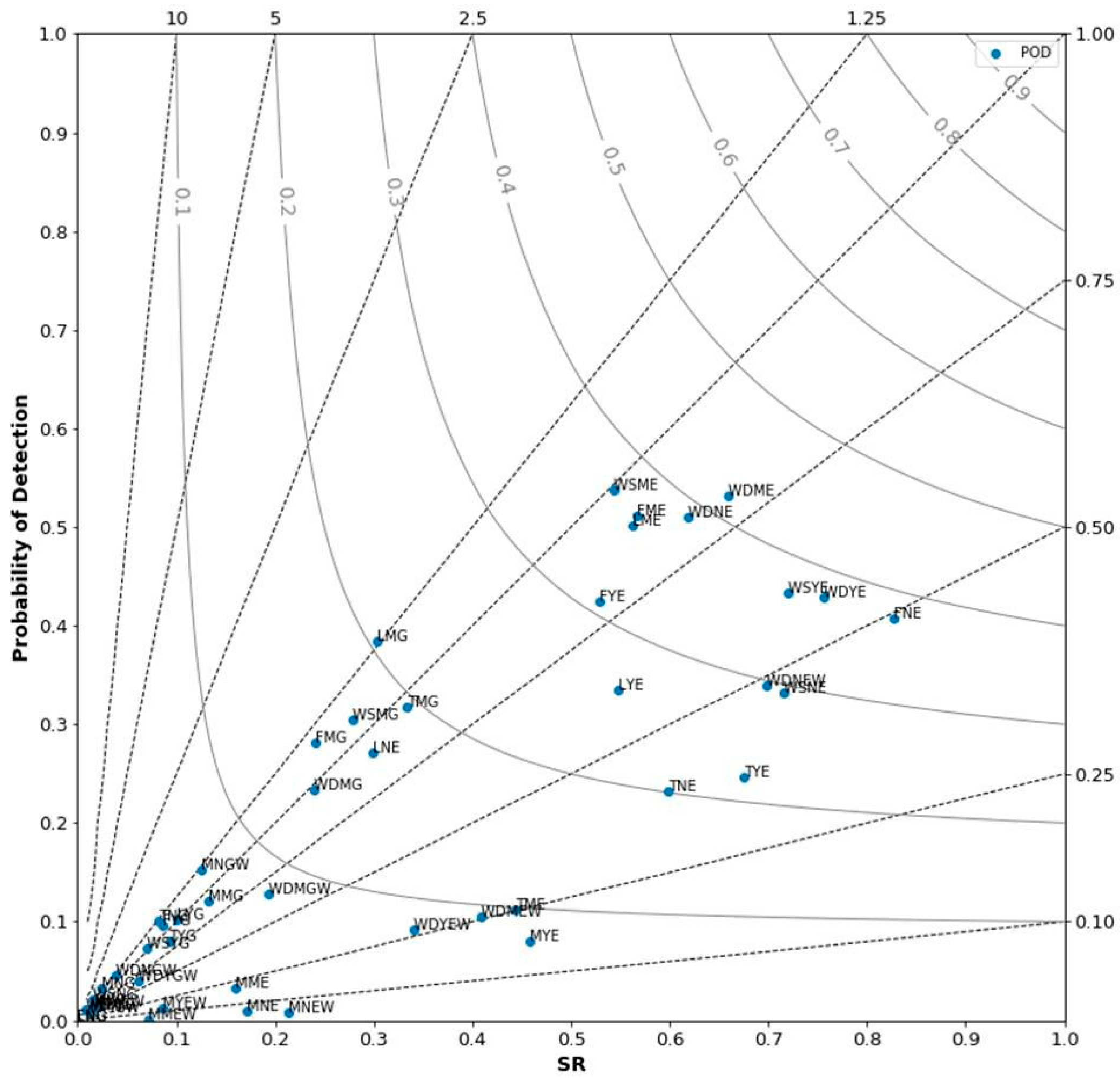

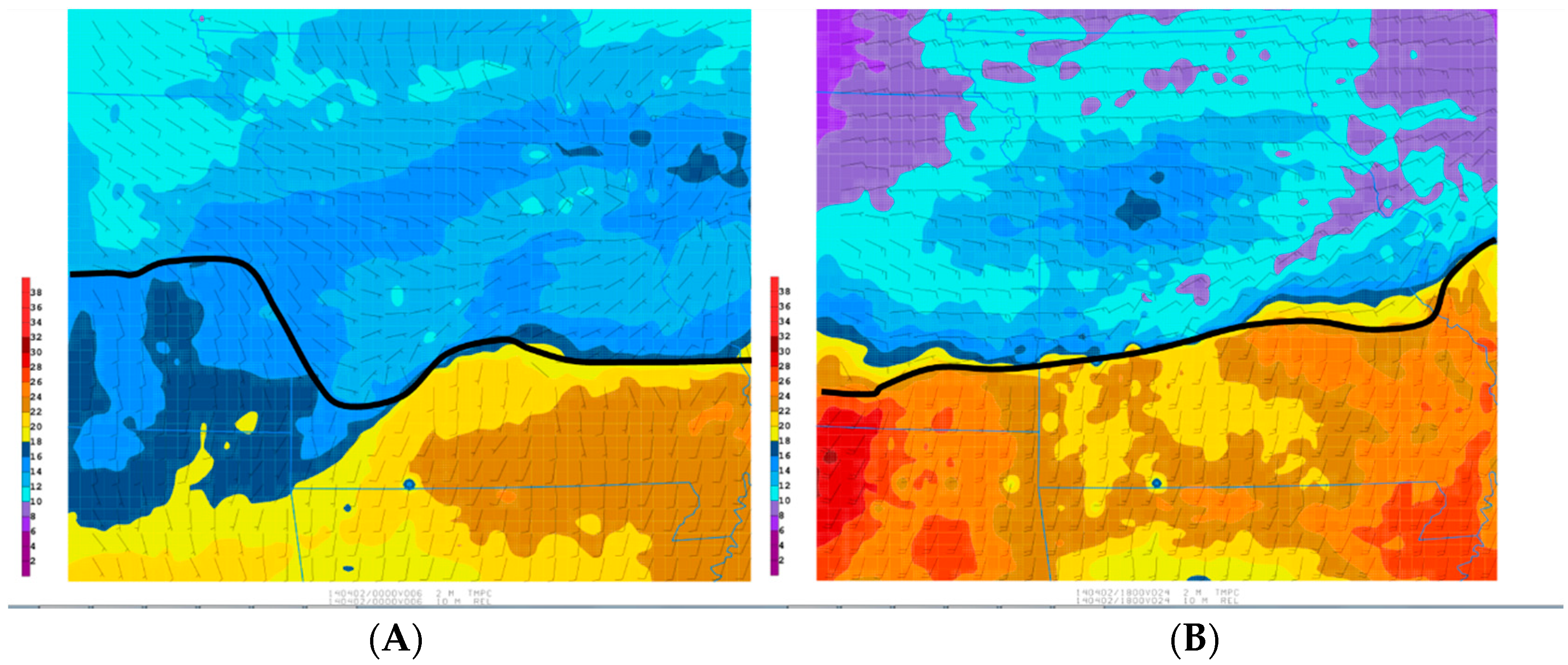
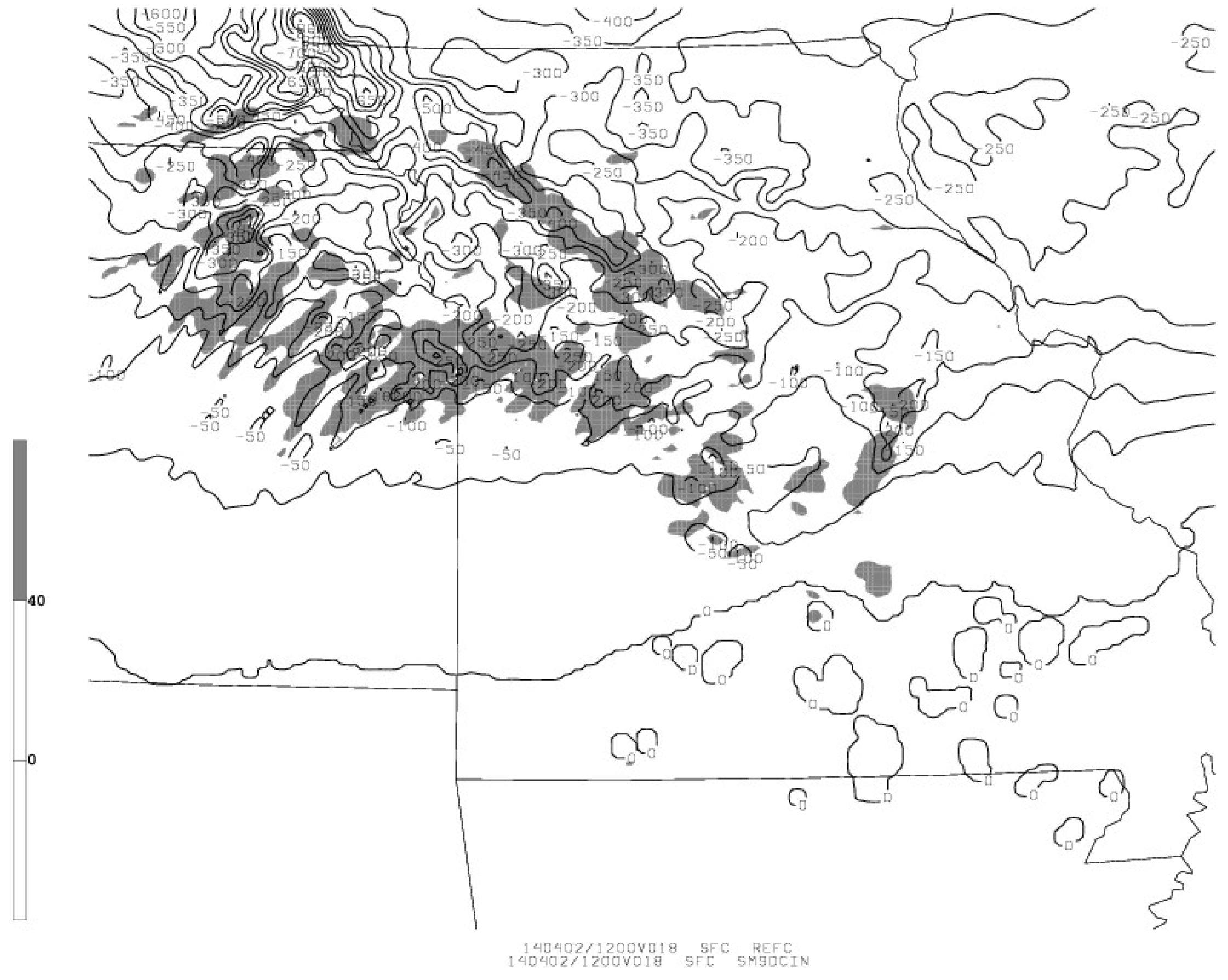
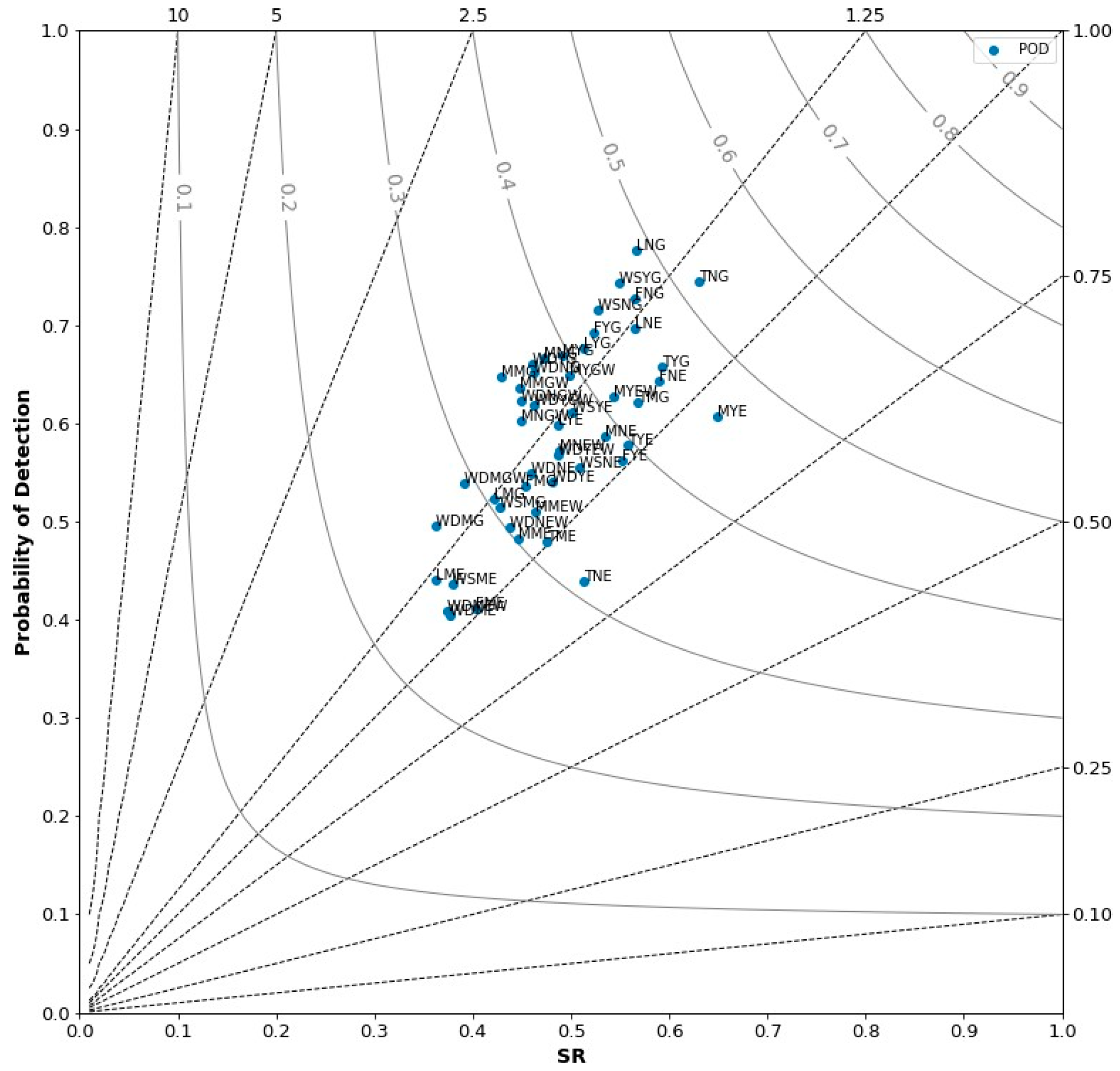

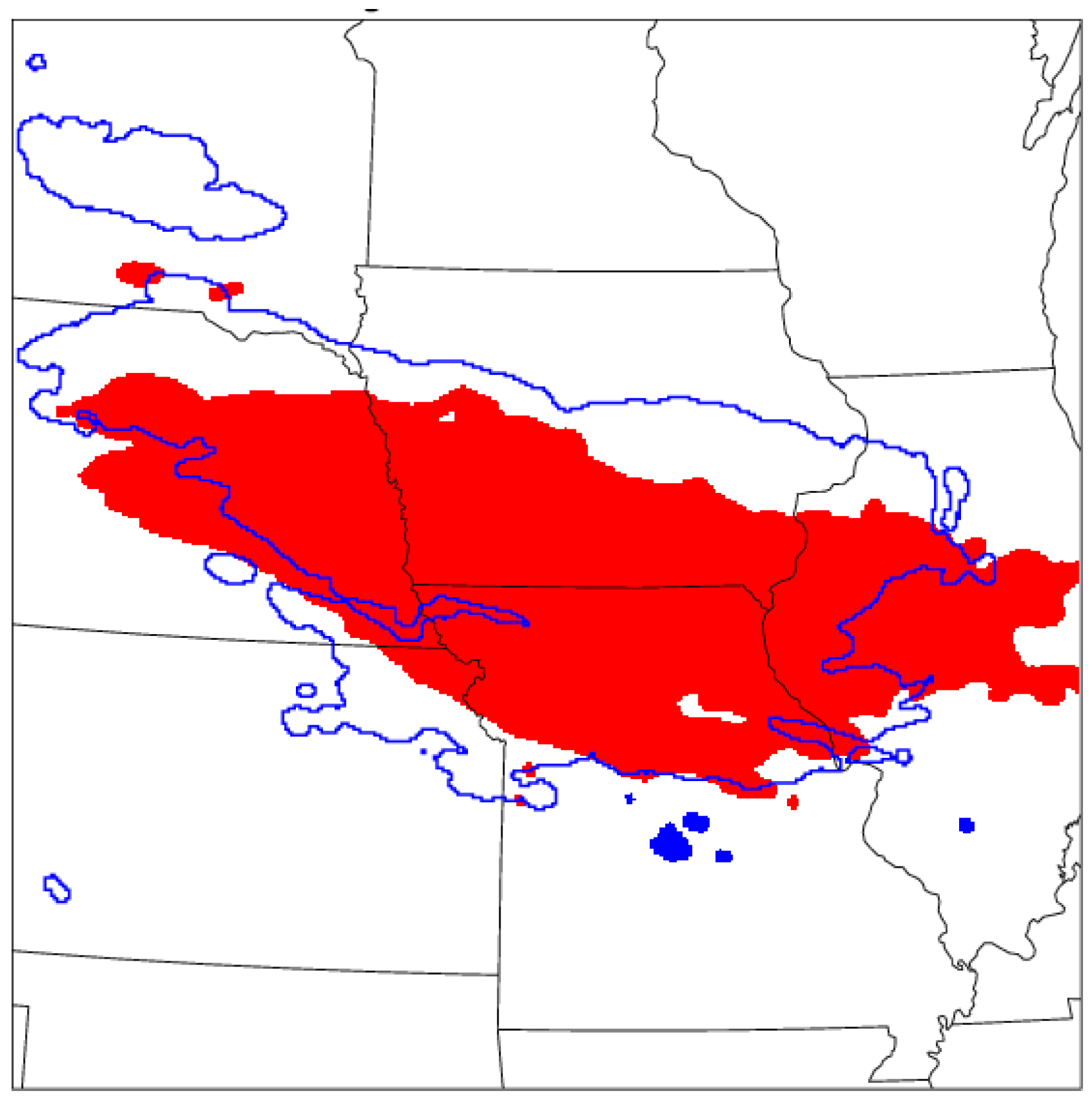

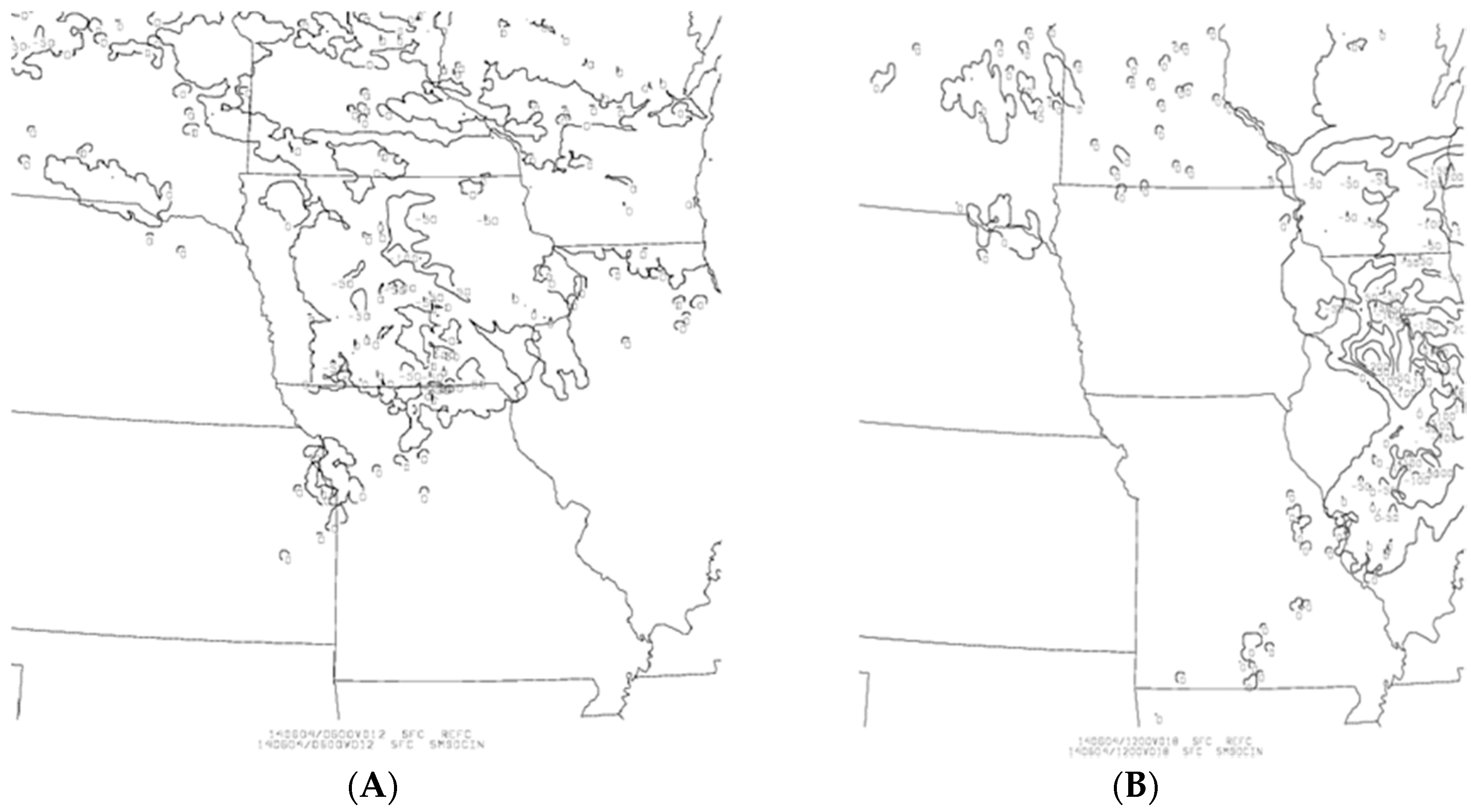
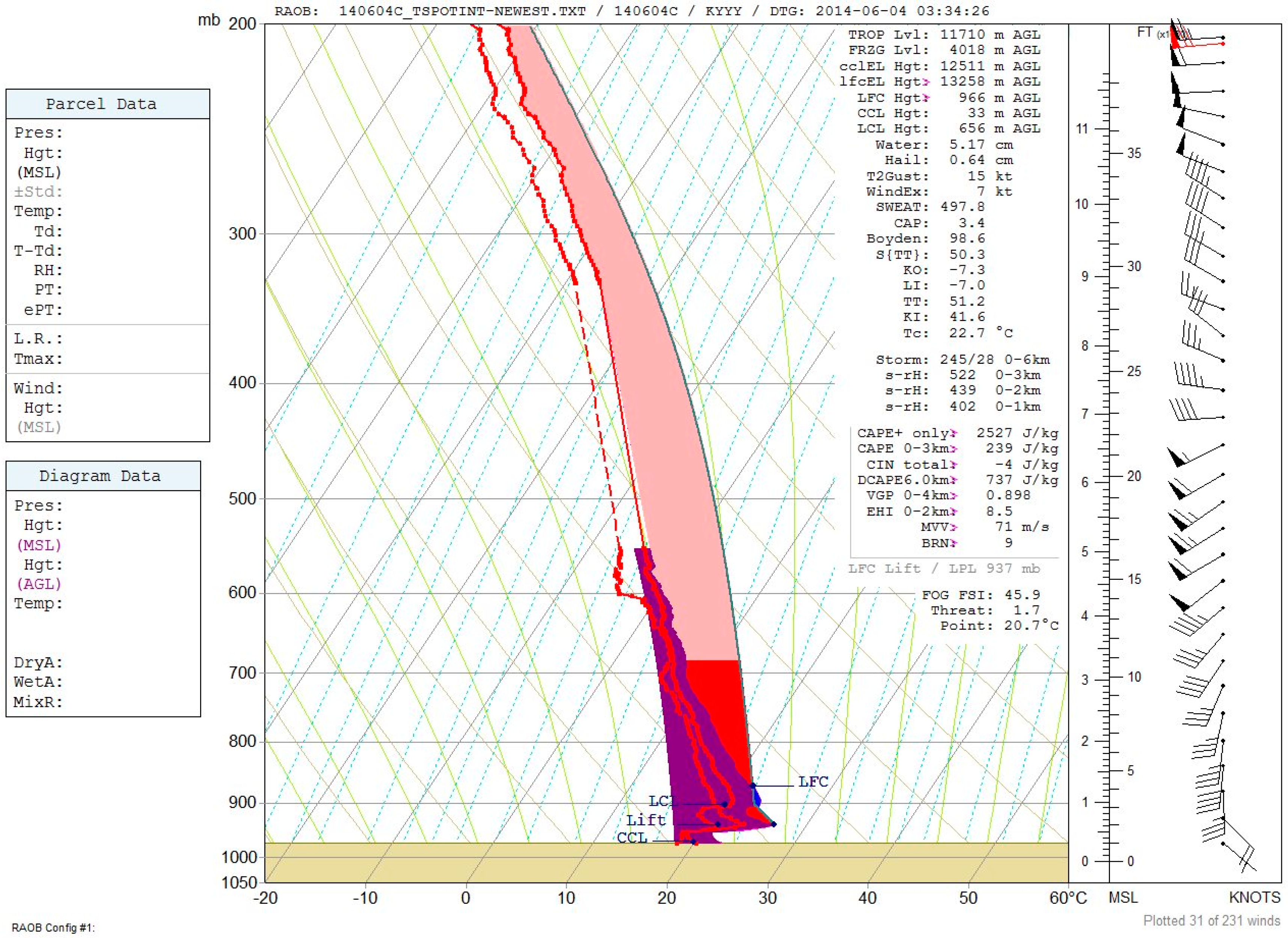
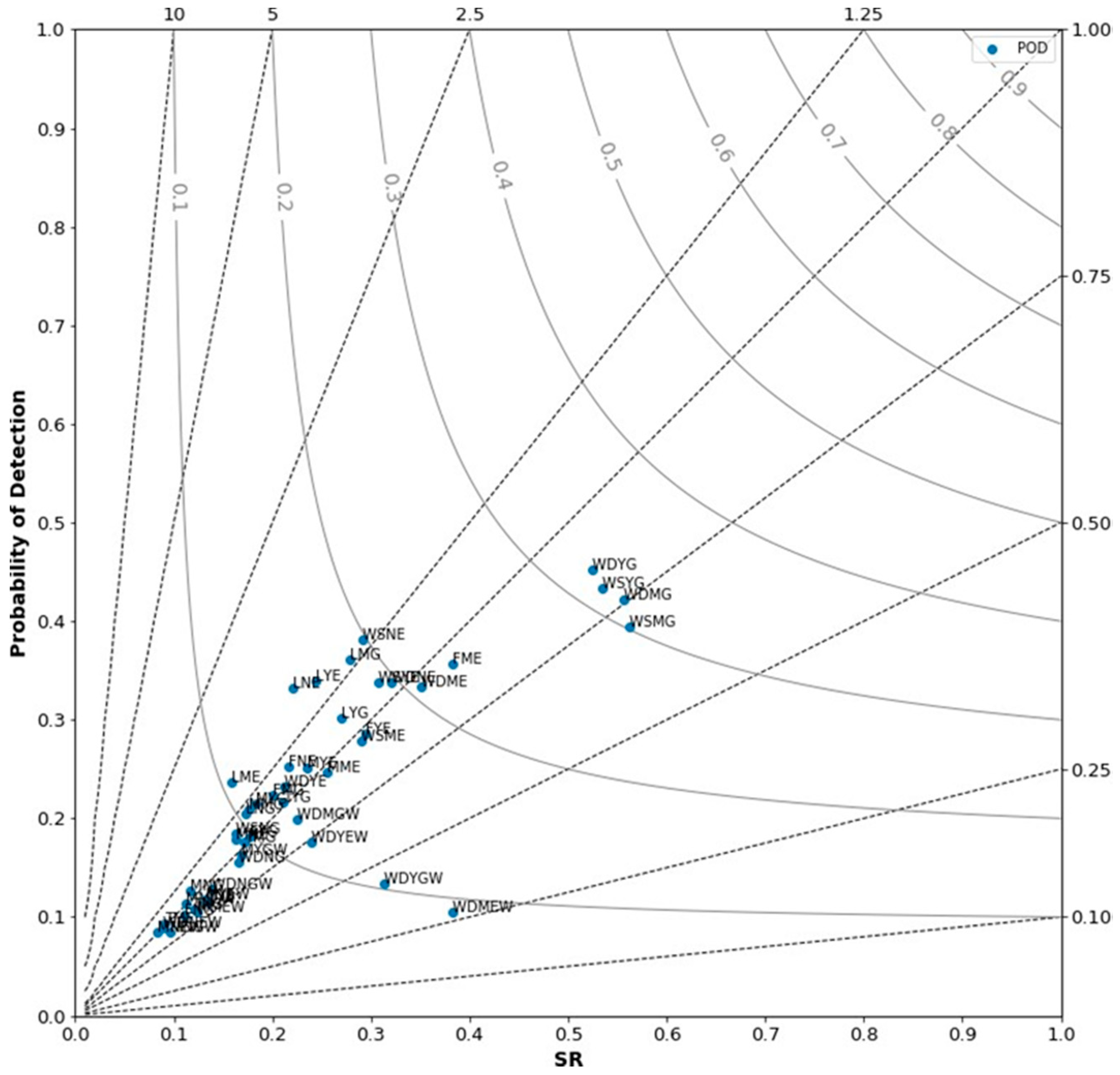
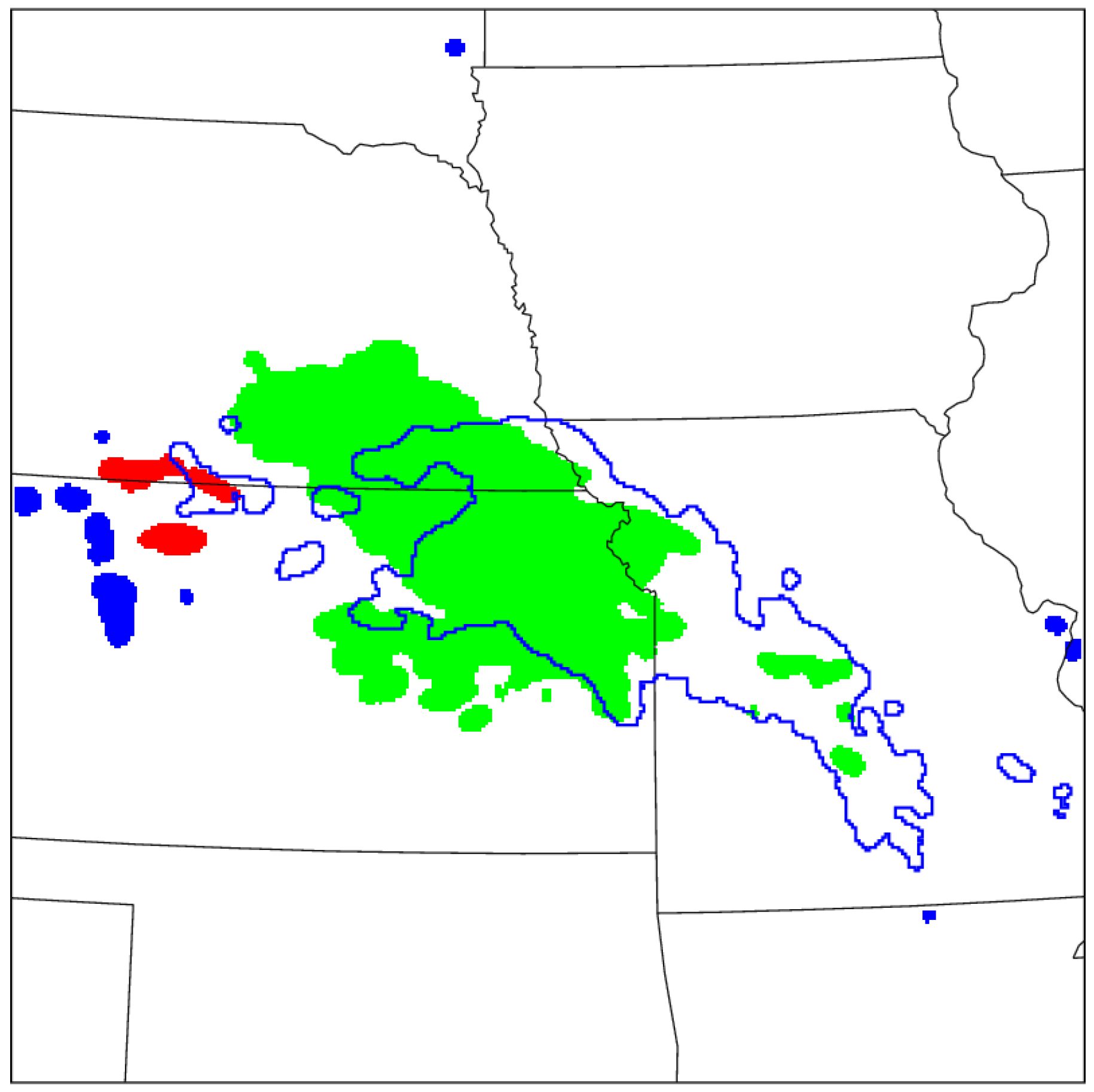
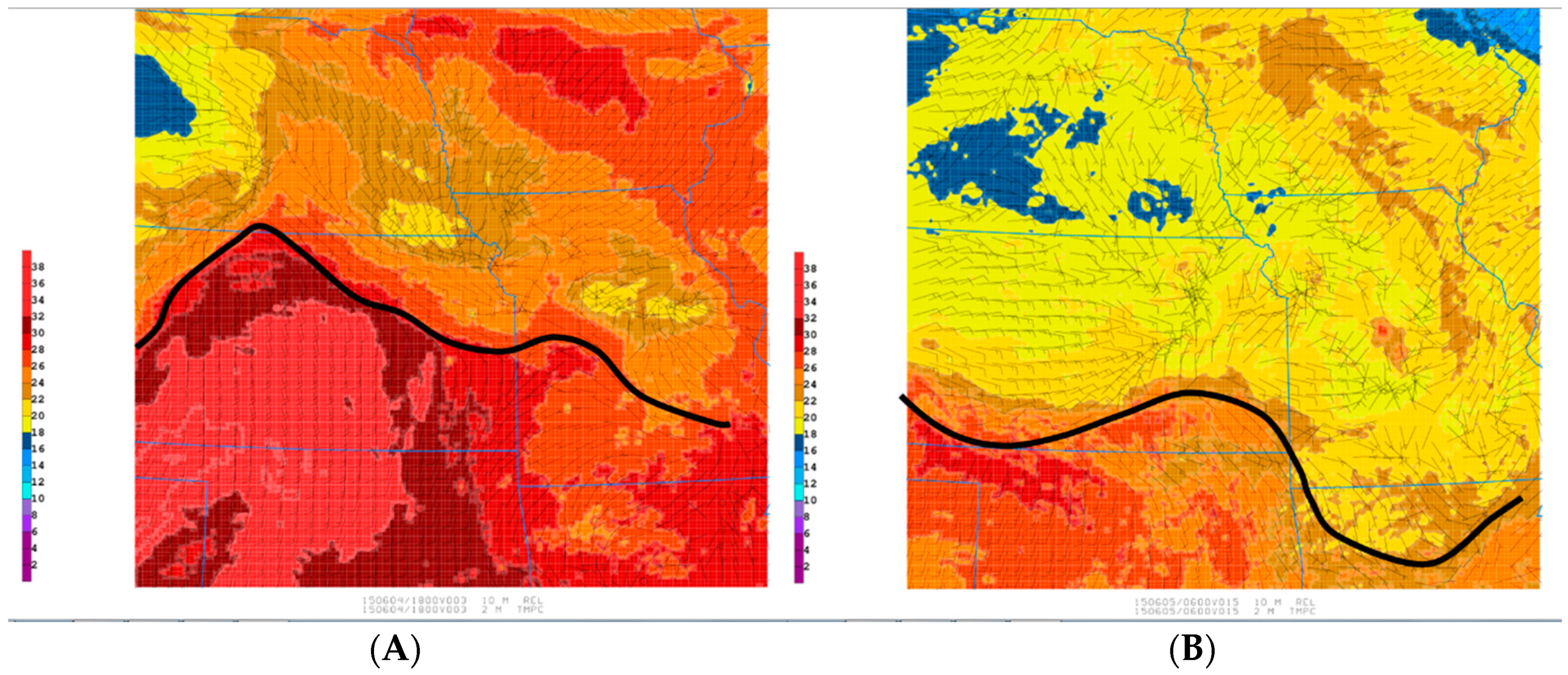
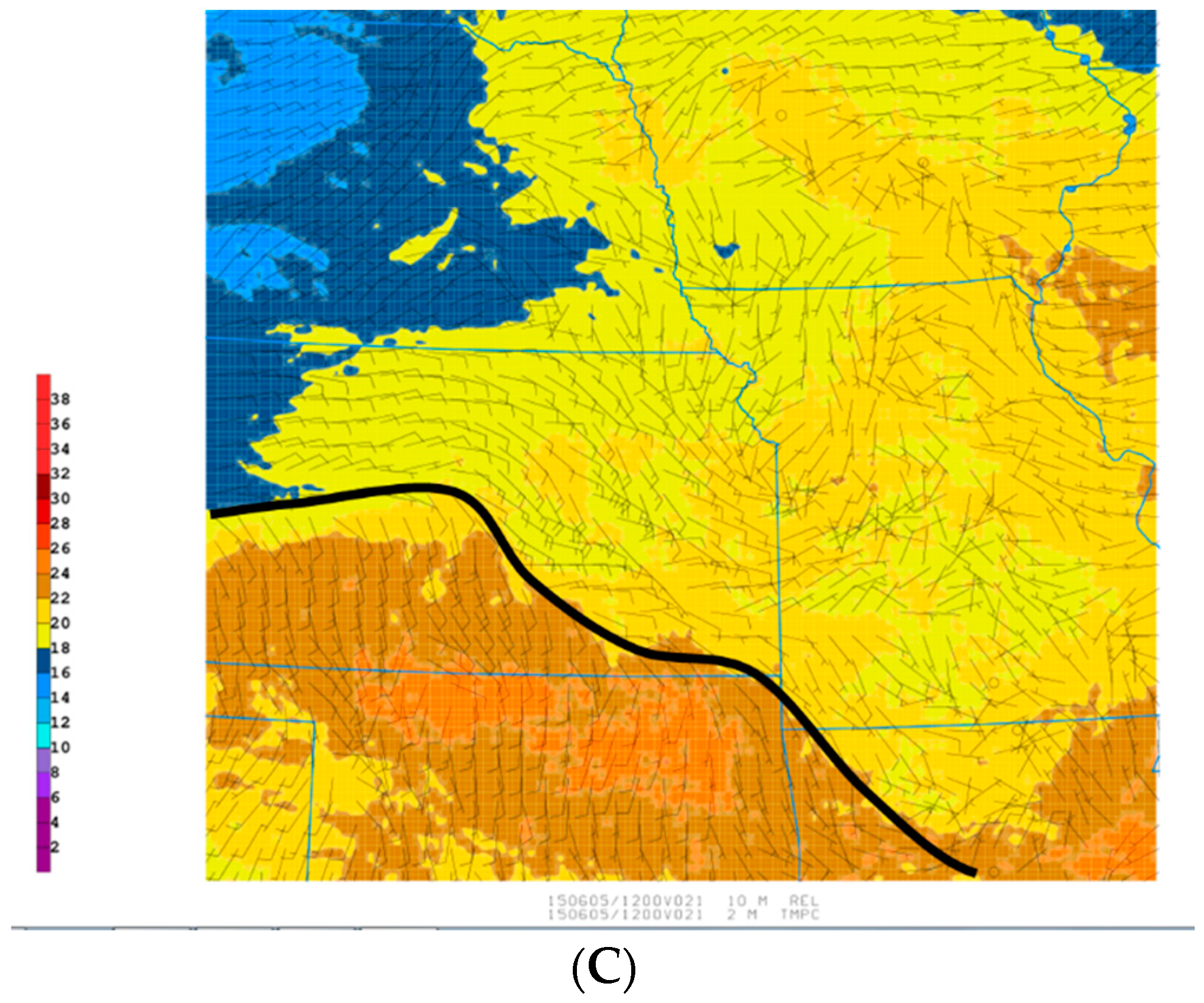
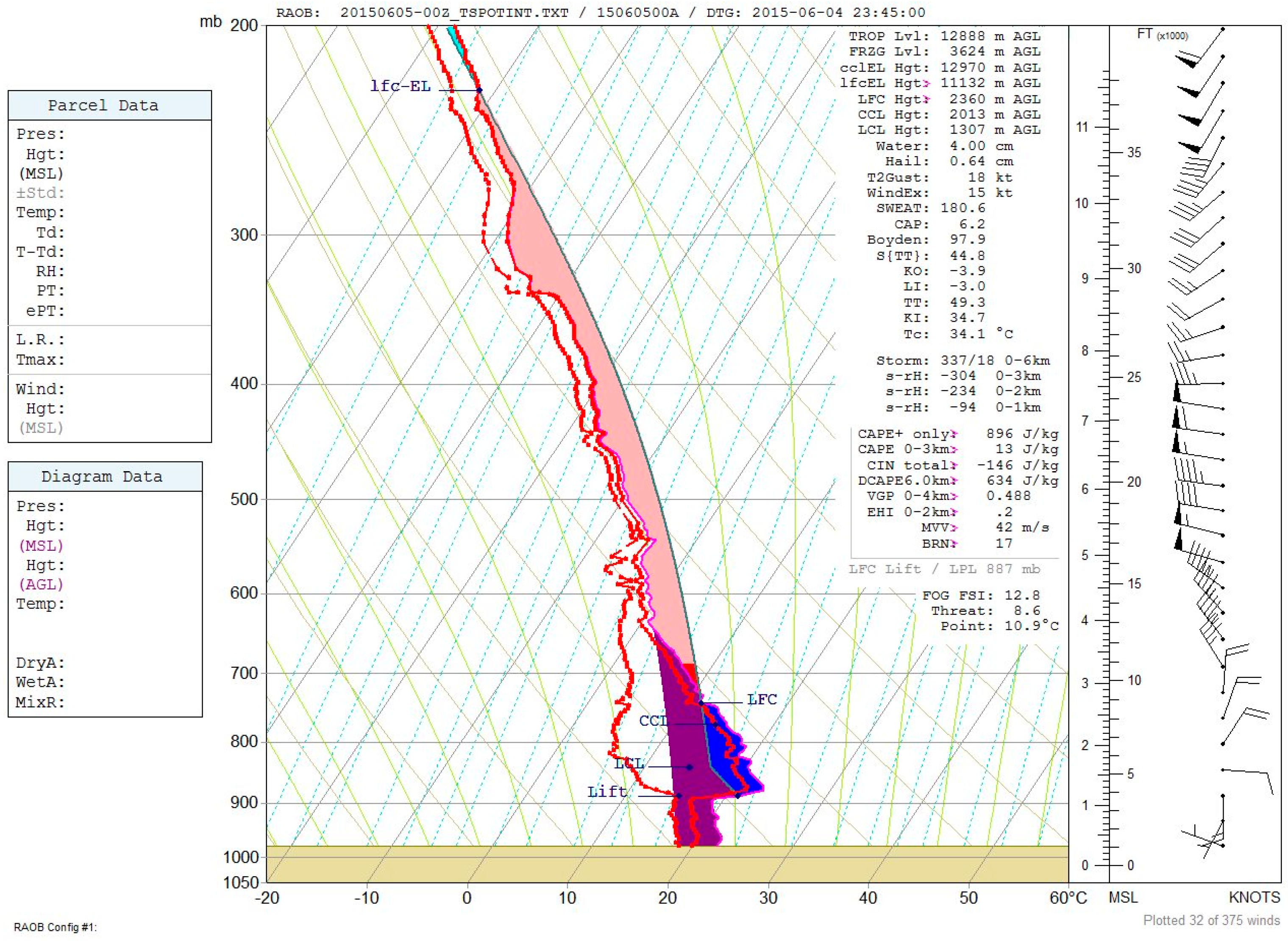
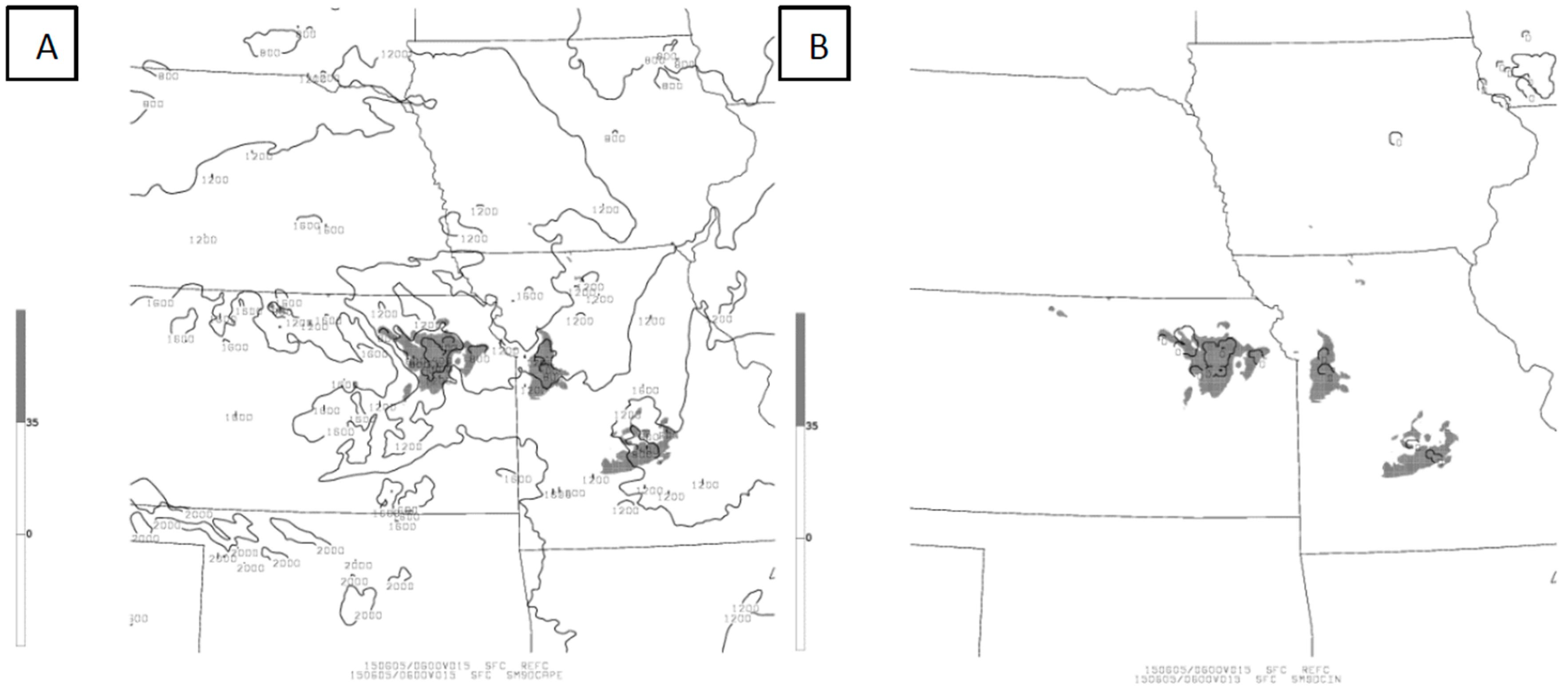
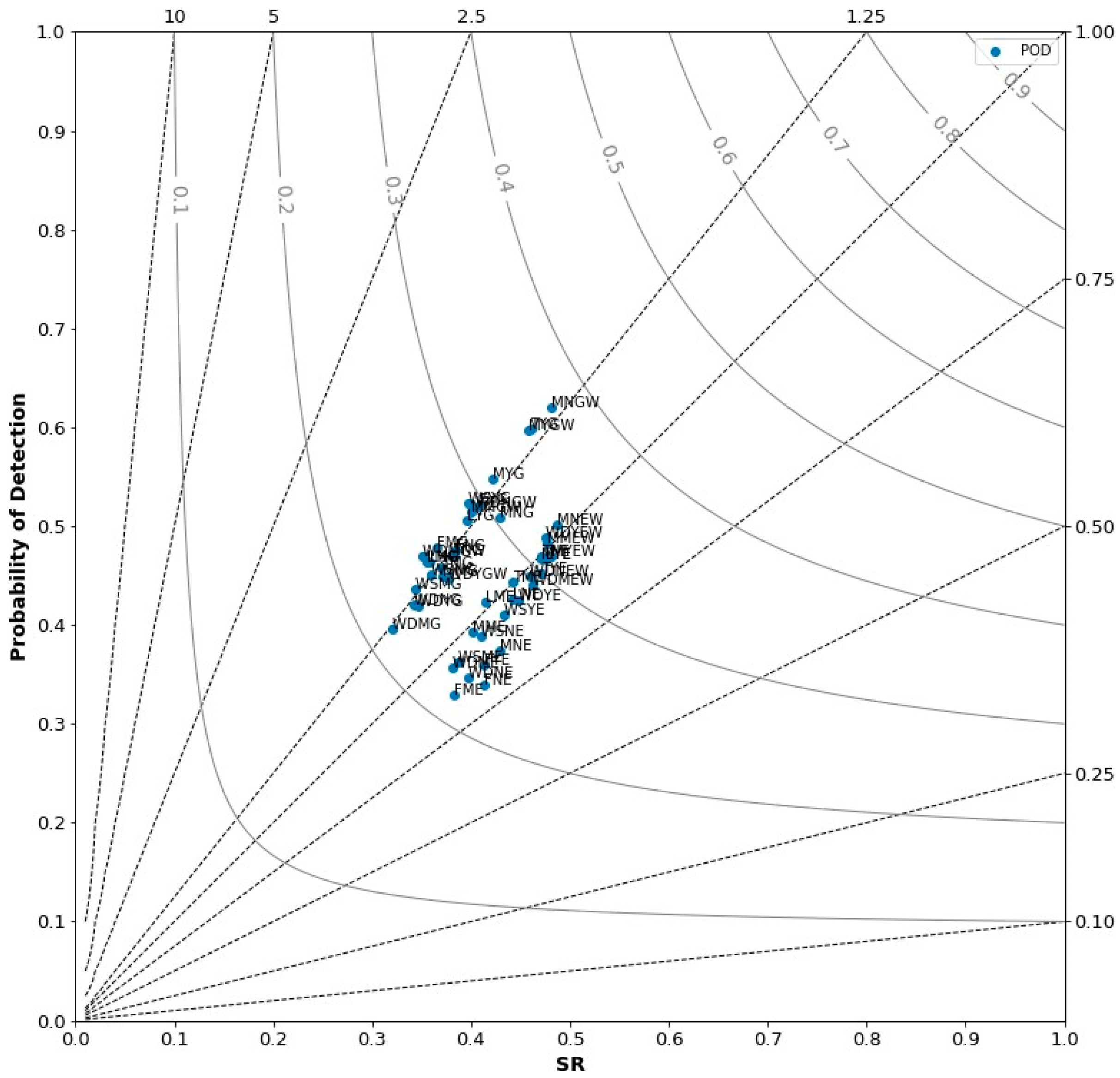
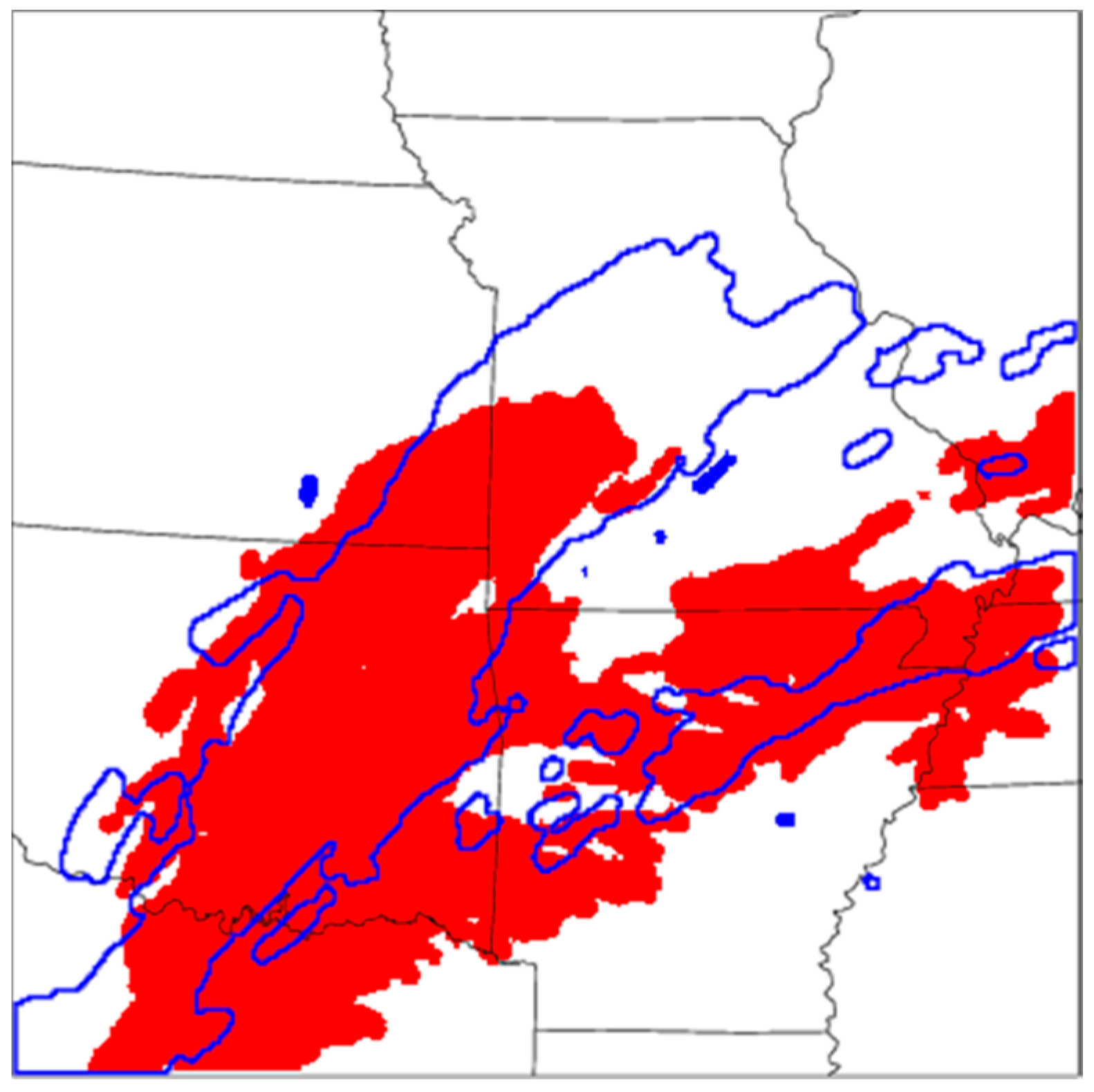
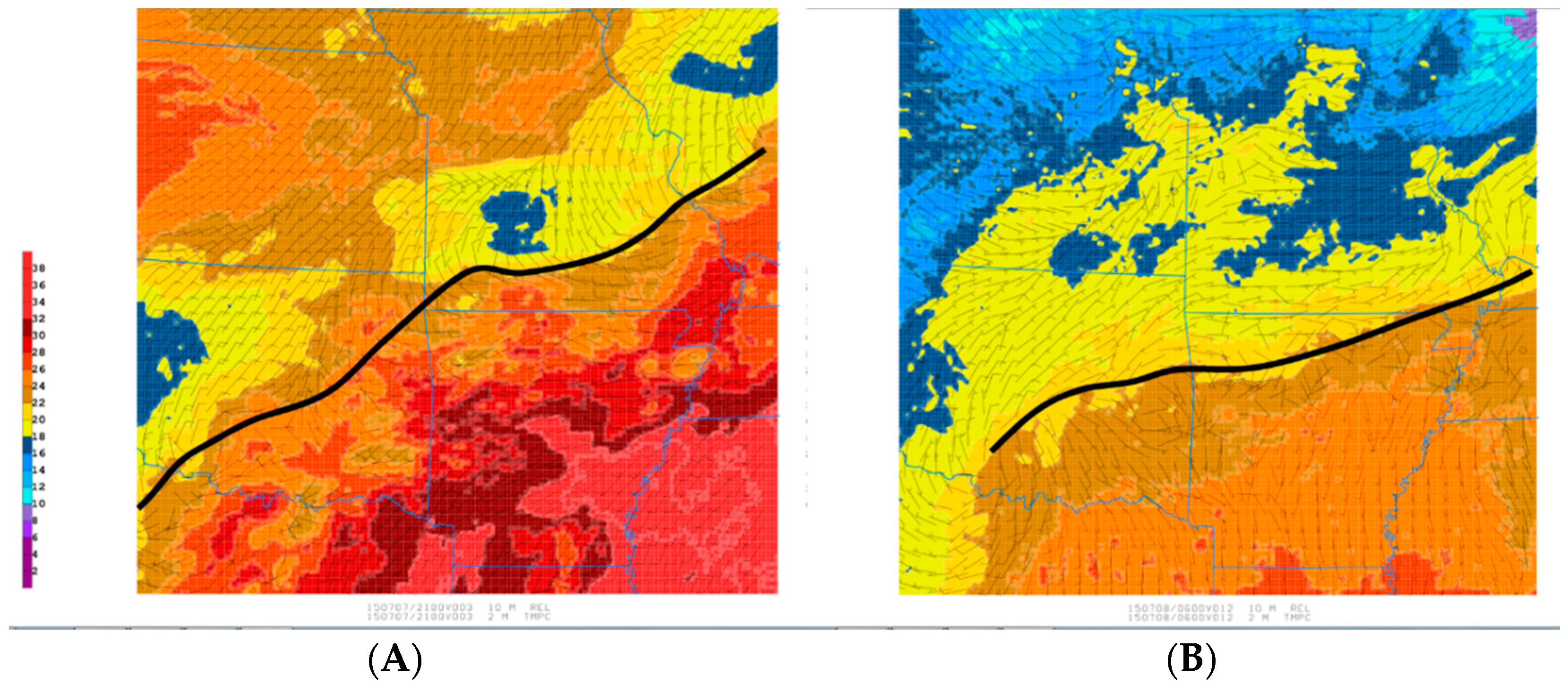
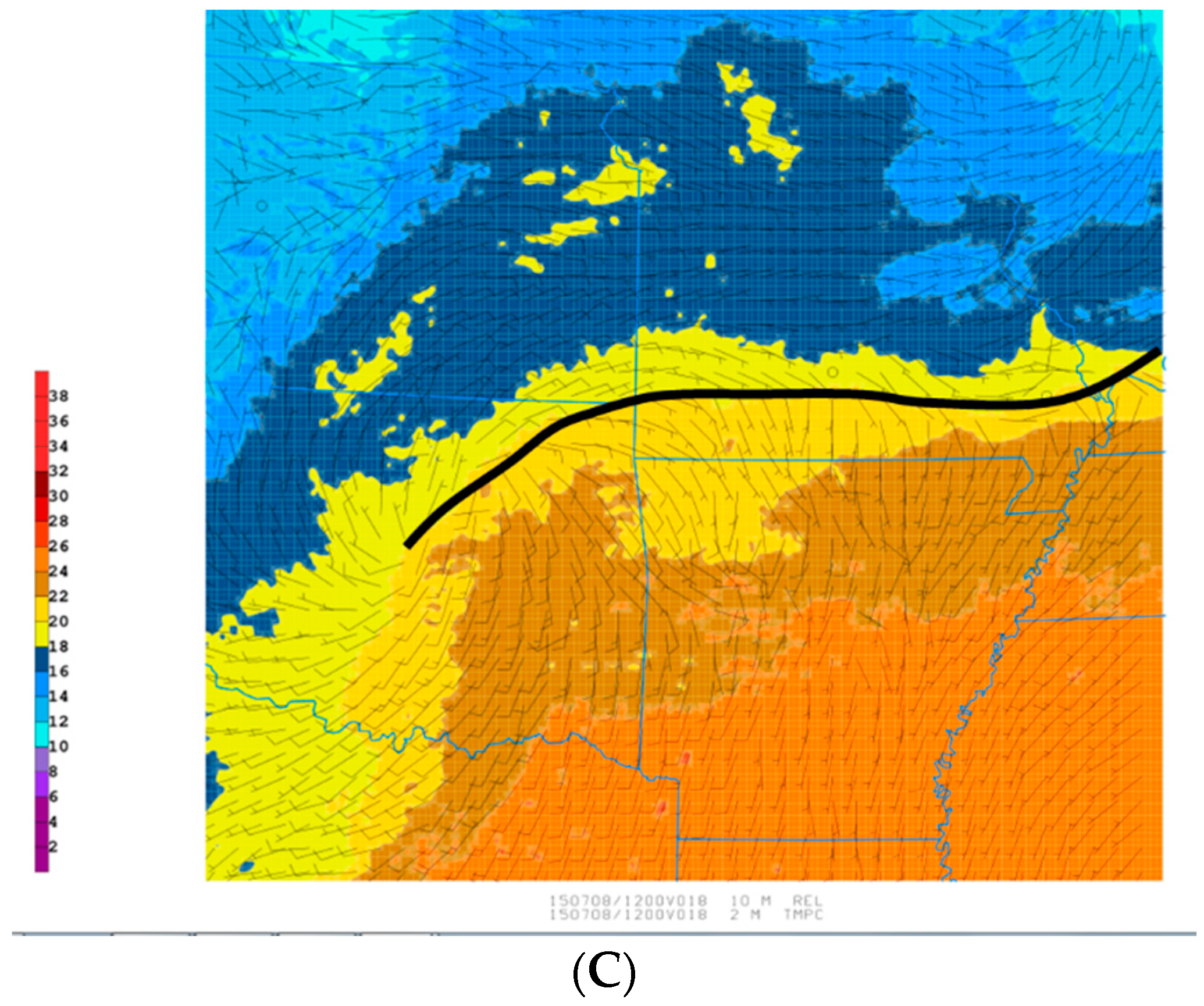
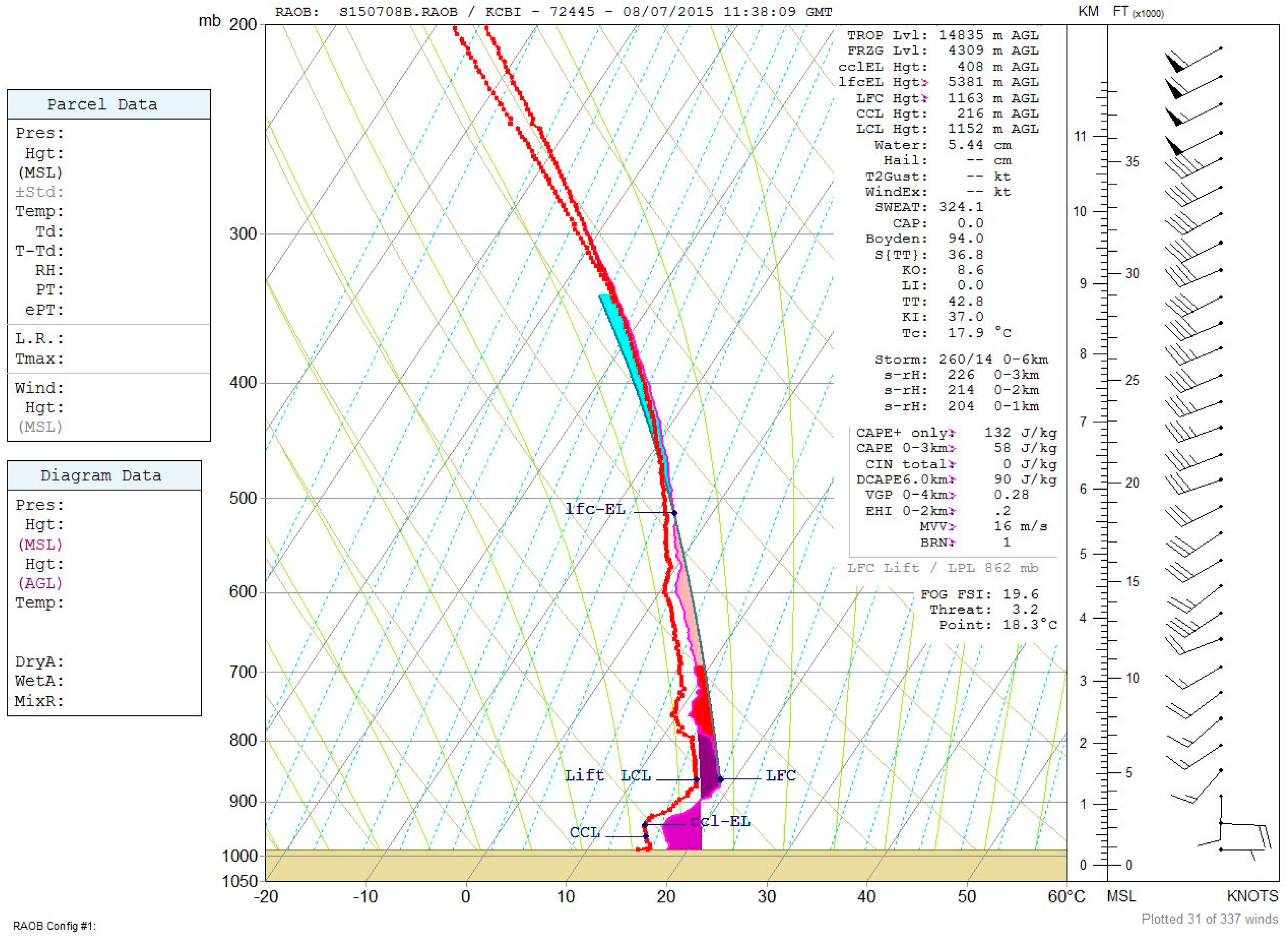
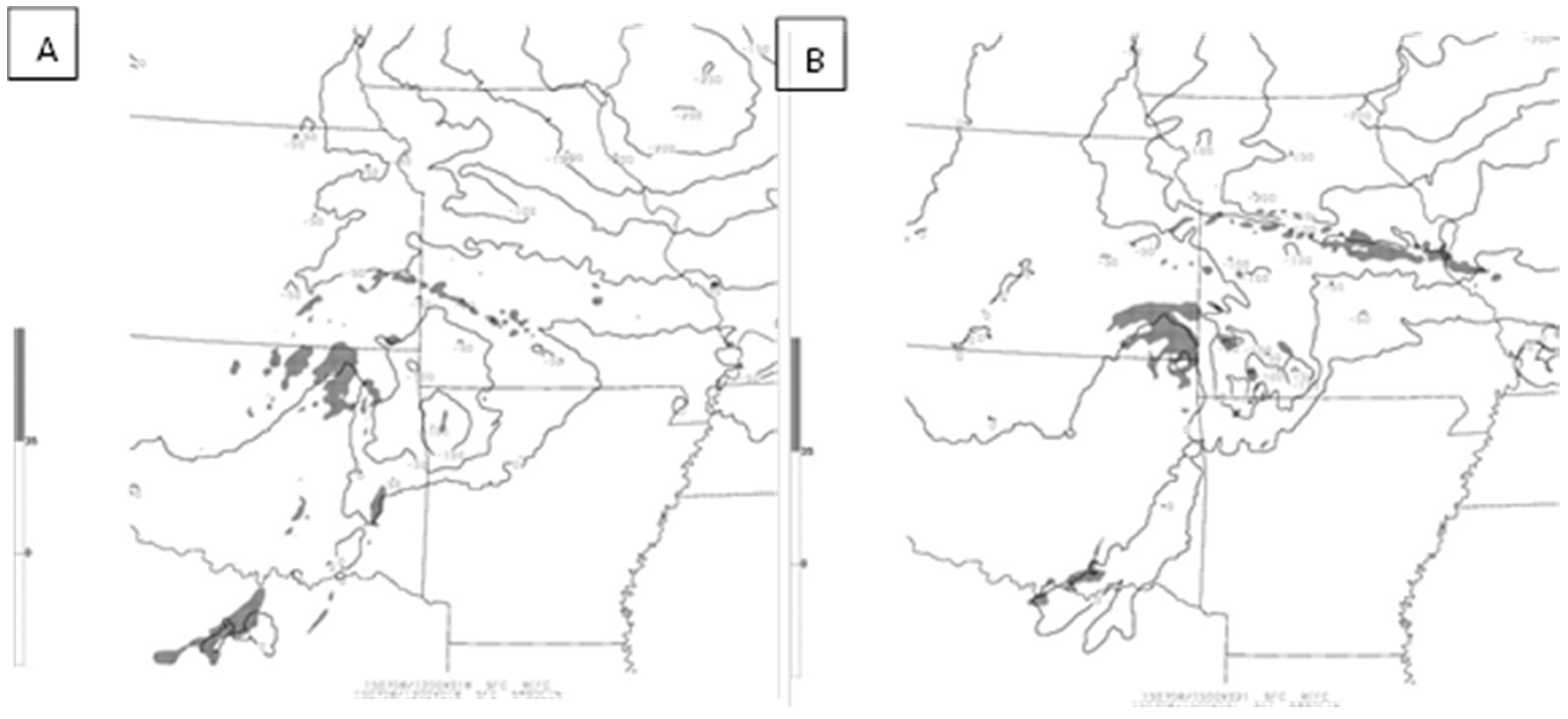
| Date | Location | Brief Synoptic Description |
|---|---|---|
| IOP 1: 1–2 April 2014 | West Central Missouri | Warm front lifting northward, front did not stall |
| IOP 2: 3–4 June 2014 | Southeast Nebraska | Warm front stalled and sank southward |
| IOP 5: 4–5 June 2015 | Southeast Nebraska | Warm front stalled and sank southward |
| IOP 8: 7–8 July 2015 | Central Missouri | Warm front lifting northward, front did not stall |
| Number | Name | IC | Microphysics | PBL Scheme | Cumulus Physics | Advection Scheme |
|---|---|---|---|---|---|---|
| 1 | LYE | RAP | Lin | YUS | Explicit | PD |
| 2 | LYG | RAP | Lin | YUS | Grell 3D | PD |
| 3 | LME | RAP | Lin | MYJ | Explicit | PD |
| 4 | LMG | RAP | Lin | MYJ | Grell 3D | PD |
| 5 | LNE | RAP | Lin | MYN | Explicit | PD |
| 6 | LNG | RAP | Lin | MYN | Grell 3D | PD |
| 7 | FYE | RAP | Ferrier | YUS | Explicit | PD |
| 8 | FYF | RAP | Ferrier | YUS | Grell 3D | PD |
| 9 | FME | RAP | Ferrier | MYJ | Explicit | PD |
| 10 | FMG | RAP | Ferrier | MYJ | Grell 3D | PD |
| 11 | FNE | RAP | Ferrier | MYN | Explicit | PD |
| 12 | FNG | RAP | Ferrier | MYN | Grell 3D | PD |
| 13 | WSYE | RAP | WSM 6 | YUS | Explicit | PD |
| 14 | WSYG | RAP | WSM 6 | YUS | Grell 3D | PD |
| 15 | WSME | RAP | WSM 6 | MYJ | Explicit | PD |
| 16 | WSMG | RAP | WSM 6 | MYJ | Grell 3D | PD |
| 17 | WSNE | RAP | WSM 6 | MYN | Explicit | PD |
| 18 | WSNG | RAP | WSM 6 | MYN | Grell 3D | PD |
| 19 | TYE | RAP | Thompson | YUS | Explicit | PD |
| 20 | TYG | RAP | Thompson | YUS | Grell 3D | PD |
| 21 | TME | RAP | Thompson | MYJ | Explicit | PD |
| 22 | TMG | RAP | Thompson | MYJ | Grell 3D | PD |
| 23 | TNE | RAP | Thompson | MYN | Explicit | PD |
| 24 | TNG | RAP | Thompson | MYN | Grell 3D | PD |
| 25 | MYE | RAP | Morrison | YUS | Explicit | PD |
| 26 | MYG | RAP | Morrison | YUS | Grell 3D | PD |
| 27 | MME | RAP | Morrison | MYJ | Explicit | PD |
| 28 | MMG | RAP | Morrison | MYJ | Grell 3D | PD |
| 29 | MNE | RAP | Morrison | MYN | Explicit | PD |
| 30 | MNG | RAP | Morrison | MYN | Grell 3D | PD |
| 31 | MYEW | RAP | Morrison | YUS | Explicit | WENO |
| 32 | MYGW | RAP | Morrison | YUS | Grell 3D | WENO |
| 33 | MMEW | RAP | Morrison | MYJ | Explicit | WENO |
| 34 | MMGW | RAP | Morrison | MYJ | Grell 3D | WENO |
| 35 | MNEW | RAP | Morrison | MYN | Explicit | WENO |
| 36 | MNEG | RAP | Morrison | MYN | Grell 3D | WENO |
| 37 | WDYE | RAP | WDM 6 | YUS | Explicit | PD |
| 38 | WDYG | RAP | WDM 6 | YUS | Grell 3D | PD |
| 39 | WDME | RAP | WDM 6 | MYJ | Explicit | PD |
| 40 | WDMG | RAP | WDM 6 | MYJ | Grell 3D | PD |
| 41 | WDNE | RAP | WDM 6 | MYN | Explicit | PD |
| 42 | WDNG | RAP | WDM 6 | MYN | Grell 3D | PD |
| 43 | WDYEW | RAP | WDM 6 | YUS | Explicit | WENO |
| 44 | WDYGW | RAP | WDM 6 | YUS | Grell 3D | WENO |
| 45 | WDMEW | RAP | WDM 6 | MYJ | Explicit | WENO |
| 46 | WDMGW | RAP | WDM 6 | MYJ | Grell 3D | WENO |
| 47 | WDNEW | RAP | WDM 6 | MYN | Explicit | WENO |
| 48 | WDMGW | RAP | WDM 6 | MYN | Grell 3D | WENO |
© 2018 by the authors. Licensee MDPI, Basel, Switzerland. This article is an open access article distributed under the terms and conditions of the Creative Commons Attribution (CC BY) license (http://creativecommons.org/licenses/by/4.0/).
Share and Cite
Kastman, J.; Market, P.; Fox, N. Dynamic Ensemble Analysis of Frontal Placement Impacts in the Presence of Elevated Thunderstorms during PRECIP Events. Atmosphere 2018, 9, 339. https://doi.org/10.3390/atmos9090339
Kastman J, Market P, Fox N. Dynamic Ensemble Analysis of Frontal Placement Impacts in the Presence of Elevated Thunderstorms during PRECIP Events. Atmosphere. 2018; 9(9):339. https://doi.org/10.3390/atmos9090339
Chicago/Turabian StyleKastman, Joshua, Patrick Market, and Neil Fox. 2018. "Dynamic Ensemble Analysis of Frontal Placement Impacts in the Presence of Elevated Thunderstorms during PRECIP Events" Atmosphere 9, no. 9: 339. https://doi.org/10.3390/atmos9090339
APA StyleKastman, J., Market, P., & Fox, N. (2018). Dynamic Ensemble Analysis of Frontal Placement Impacts in the Presence of Elevated Thunderstorms during PRECIP Events. Atmosphere, 9(9), 339. https://doi.org/10.3390/atmos9090339






